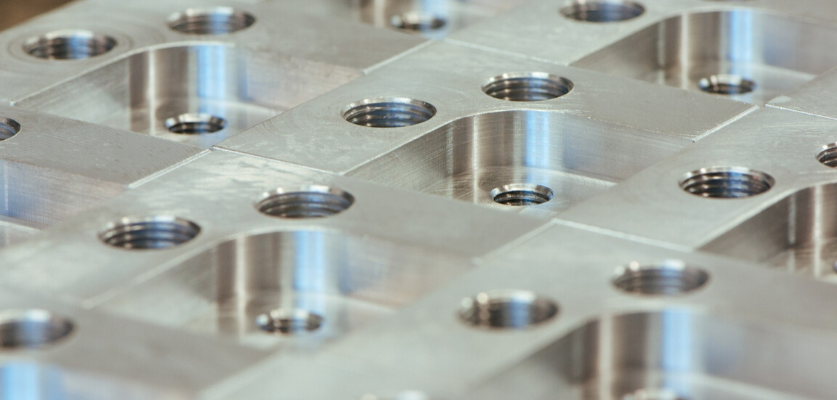How does the surface grinding process achieve parallelism and squareness?
At its most basic, precision surface grinding is used to achieve two things: to make cubic shapes of metal square and parallel. Utilized for many applications, but typically fixtures, molds, and dies, surface grinding services seem simple at first glance.
But look deeper and you’ll find there’s more to mastering surface grinding than meets the eye.
Applications for Precision Surface Grinding
For six-sided cubic rectangular or square pieces of metal, precision surface grinding enables you to make each side square and parallel to itself or a reference surface. These square or rectangular blocks are usually held in place on the grinding table by magnets, so that you have one flat surface against another flat surface.
From that critical foundation, surface grinding can be invaluable for applications such as die manufacturing. The positional accuracy required by dies used in extrusion and injection molding means the dies must be square to the outside of the center, and it is here that precision surface grinding delivers.
You simply cannot mill a block of metal as squarely and precisely as you can surface grind it — not to mention, the milled surface will never match the ground finish for a smooth, low Ra value.
Surface grinding services can also be used on rods, although not to make the outside diameter of a rod round; for that task, OD grinding (also known as cylindrical grinding) is used. However, surface grinding can make the two ends of a rod perfectly perpendicular to the outside diameter.
Here, V-blocks are used to position rods for grinding. A round rod is placed into the V-shaped cavity, and a clamp holds the rod vertically in place. From there, precision surface grinding can be used to grind the top of the rod to a dimension that is perfectly square to the outside diameter.
Various Sizes of Surface Grinding Machines
The surface grinding concept is the same no matter the size of the part to be ground. However, as with many machine tools, the size of a surface grinding machine can range from small to very, very large.
At Metal Cutting Corporation, our expertise is at the small end of the spectrum, with precision surface grinding machines optimized for the tightest tolerances and on the smallest beds, appropriate for the very small parts we produce.
As surface grinders grow in size, there are trade-offs for tolerances. However, where you have a very large part, it is best served by the capabilities of surface grinders on the large end of the spectrum.
At the largest end is the Blanchard grinder, an older technology that is considered surface grinding although its rotating disk results in a very different surface finish pattern.
Removing Material in Increments
Although there are manual surface grinding tools, a critical feature of surface grinding services is the precise, repeating removal of small increments of material by machine. Here, the less you remove, the better the surface finish and the better the dimensional accuracy.
It is not advisable to remove a lot of material thickness in one pass, because it will produce a bad surface finish. Additionally, applying that type of stress on both the metal and the machine can result in poor positional accuracy and possible fracturing of the workpiece.
Rather, it is far better to make many, many repetitious passes, with each one removing slightly more material.
That makes watching automatic surface grinders like seeing a perfectly choreographed, rapidly repeating side-to-side motion where each interval is imperceptibly moving just a little lower into the metal part, removing a remarkably small amount of material with each pass. The machines perform their task with none of the vibration and noise that accompanies metal removal by turning.
There is an exception to this incremental removal of material, in the form of creep-feed grinding — a method of precision surface grinding originally designed to remove a large amount of material in one pass.
However, it was quickly discovered that the fast reciprocating motion typically used with surface grinding was not suitable; therefore, creep-feed grinding machines were engineered with a very slow feed rate.
Intriguingly, at Metal Cutting we still have some of the old creep-feed automatic grinders that are now out of production. So, we are able to use creep-feed techniques on a smaller scale to enhance surface finish, even when material removal rates are not the main focus.
The X-Y-Zs of Precision Surface Grinding
The usual standards for surface grinding services are also the principles of motion that drive the grinding table, with one difference — the horizontal X axis action that provides the side to side repetitions and the Z axis grinding action that provides the back and forth passes. Sophisticated precision surface grinding machines have automatic Z axis, allowing for the tiniest of increments to be applied to the workpiece with each of the X axis repetitions.
Yes, you read that right — in the world of surface grinding, the vertical direction is the Z axis, whereas in milling that is called the Y axis.
And then there is the Y axis. On precision surface grinding machines, typically the wheels are not as wide as OD grinding or centerless grinding wheels. The benefit of the Y axis motion is that it allows a 1” thick wheel to precisely grind flat a surface that is more than 1” wide.
In fact, workpieces can be many multiples wider than the grinding wheel. With each repetition of the X axis, the Y axis is moving ever so slightly to produce the specified flat surface. Across the many different sizes of surface grinders, the same X-Y-Z principles apply.
Variables That Drive Surface Finish Results
Although the principles of precision surface grinding seem simple, the practice of surface grinding requires years of experience because there are many subtle variations.
As with all skilled and productive machinists, surface grinding experts need to understand not only the behavior of different metals, but also certain variables that drive the surface finishes that precision grinding machines will produce.
Feeds and speeds
In the case of precision surface grinding, feed refers to the rate of the three axes. Arguably, feed is the major deciding factors for achieving the desired surface finish.
Speed refers to the wheel RPM, although interestingly, the wheel RPM is usually constant in surface grinding. This is because even though a grinding wheel does wear — a factor you would normally think requires adjustment of wheel speed to maintain a consistent grind — it does so imperceptibly in relation to the diameter of the wheel.
Wheel selection
In surface grinding services, the opportunities to choose the perfect wheel are as wide as the selection and variety of wheels that are available. However, expertise comes in knowing the limited number of optimal wheels for each of the many different types of metal comprising the workpiece.
For the purpose of removing material, wheels range from aluminum oxide and silicon carbide through diamond and CBN, depending on the hardness of the metal being ground and removed. There are other specialty wheels made of materials such as cork, but they are used more for burnishing and polishing rather than for material removal.
Coolants
Similarly, through years of experimentation and commercial practice, there are only a few desirable coolants. However, as with all other machining processes, the way coolant is introduced to the precision surface grinding process remains an important method to get right.
Specialized Expertise in Surface Grinding Services and More
Like many professional disciplines these days, the world of surface grinding services has many subspecialties, calling for specialized expertise. For example, beyond the simple tasks of working a cubic shape or the ends of a shaped part, there are many permutations that can be achieved through the skilled use of different attachments.
There are also many techniques and CNC-driven capabilities that apply to the robust standard surface grinding machine. These machines can be fixtured to make forms, corners, or chamfers, or to even do cut off, and fully rounded radiuses are possible. When specific shapes are desired, the methods become known as in-feed grinding, form grinding, plunge grinding, and/or profile grinding.
That means for making tight tolerance, small metal parts in many different shapes, surface grinding experts need to be skilled in many other disciplines beyond simple grinding of cubes and cylinders.
For tips on how to create specs that will give you the results you’re looking for — with precision surface grinding as well as other machining methods — check out our FAQs on How to Fine-Tune Your Quote Request to Your Maximum Advantage.






